-
A Summer of Astrobiology
October 03, 2017 / Written by: Miki Huynh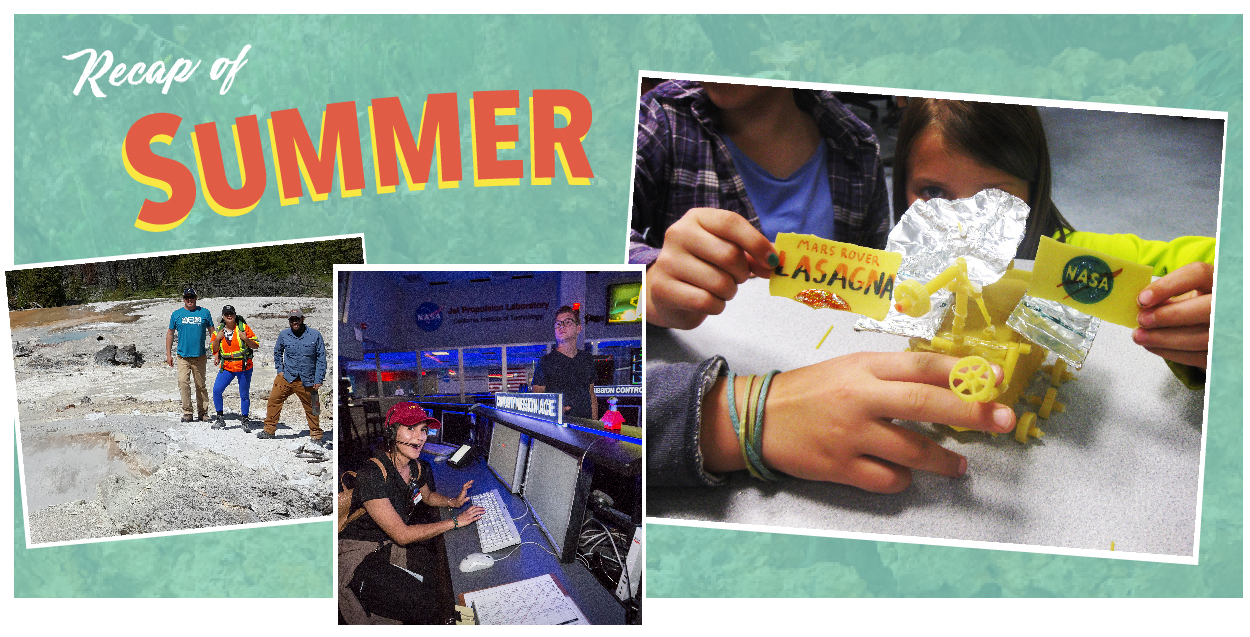
Fall is officially upon us, but not too long ago early career astrobiologists were keeping busy throughout the summer season. AbGradCon 2017 and the Proposal Writing Retreat—organized by and for post-docs, graduate students, and select undergrads—met with great success. The 2017 International Summer School in Astrobiology gathered 22 scholars to the Universidad Internacional Menéndez Pelayo (UIMP) in Santander, Spain to learn about exoplanet habitability. And undergraduates collaborating with scientists at Goddard Space Flight Center presented a GSFC Summer Research Associate 2017 Seminar on their innovative research.
PIs of the NASA Astrobiology Institute teams also report the activities and achievements of interns and young scientists engaged in astrobiology-related programs this summer—students making great impressions as they make great strides in their education and careers.
Highlighting Summer StudentsThrough the Alternative Earths team (based at the University of California, Riverside), graduate student Christopher Tino travelled to southern Germany, sampling drill cores from Nördlinger Ries, a Miocene-aged impact crater containing a remarkably continuous record of an ancient alkaline lake system. Tino analyzed the geochemistry and associated life of these sediments, and he assessed the analog value of the Nördlinger Ries crater as part of ongoing exploration for past life in ancient crater-fill sediments on Mars. He worked closely with his advisor, Alternative Earths PI Tim Lyons, as well as former NASA Postdoctoral Program Fellow Eva Stüeken, an astrobiologist and newly hired Lecturer in the Department of Earth & Environmental Sciences at the University of St Andrews.
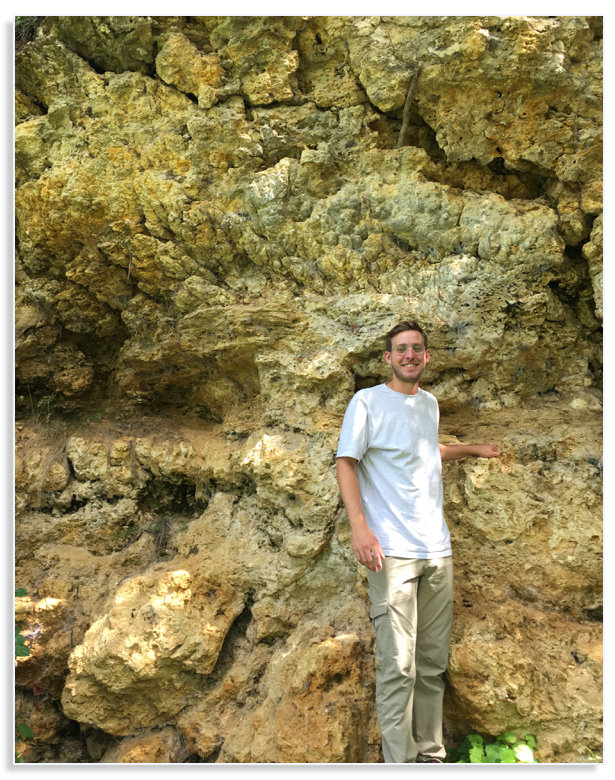
Chris Tino poses in front of a massive outcrop of fossil lacustrine microbialites in Nördlinger Ries crater, Germany. Source: UCR
Over at MIT, summer interns with the Foundations of Complex Life spent their summer coauthoring papers and attending their first international conference, the International Meeting on Organic Geochemistry in Florence, Italy.Elliott Mueller, a recent graduate from Northwestern University, worked with graduate student Emily Matys to conduct a study of membrane lipid changes in wild type and mutant, low-light-adapted cyanobacteria. In his spare time, Elliot also works on a self-designed project: a new lipid analysis methodology using subcritical water as a solute in his spare time.
Anaïs Roussell, an aspiring astrobiologist, examined the geochemistry of rocks that record environmental change across the Precambrian-Cambrian transition. Following her positive experience, Anaïs plans to return for another visit to MIT in the spring of 2018 to extend her summer study.
Noah McDaniel, an MIT sophomore, assisted on a project in the Summons Lab devised by Tyler Mackey and Kristin Bergmann, examining the biomarker hydrocarbons present in rocks from Svalbard that record events leading up to and through the time period of Snowball Earth.

Elliott Mueller, Anaïs Roussell, and Noah McDaniel. Source: MIT
At the Virtual Planetary Laboratory (VPL) based at the University of Washington, students Renae Stanley and Melvin (Sunny) Miles took part in an inaugural Research Experience for Undergraduates (REU) astrobiology program organized in partnership with Northwest Indian College, within the Lummi Nation in northwestern Washington. With guidance from VPL scientists Vikki Meadows, Andrew Lincowski, Jacob Lustig-Yaeger, and Erika Harnett, Renae and Sunny received training on data analysis tools and programming languages including Matlab and Python, learned how to run planetary simulations and interpret results, and conducted a comparative study of the effect of Proxima Centauri’s UV spectrum on the atmospheric composition of an Earth-like planet.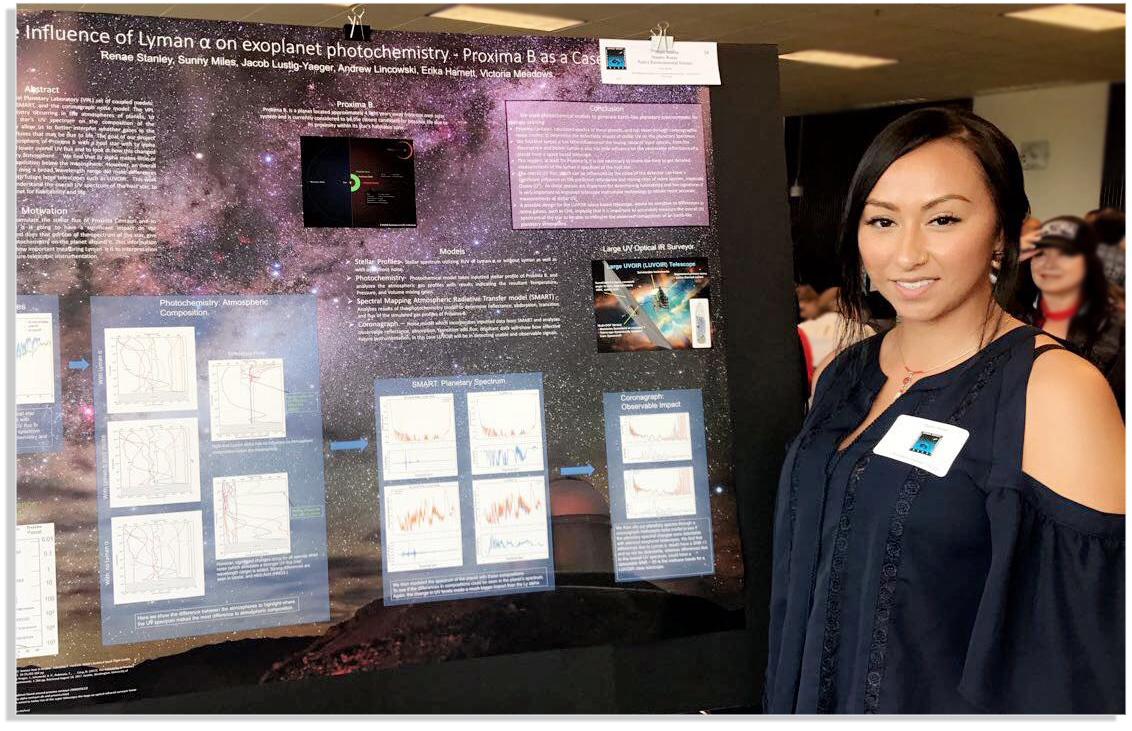
Renae Stanley. Source: VPL
Summer interns with the Icy Worlds team based at Jet Propulsion Laboratory noted the great working relationship and sense of comradery with staff scientists and fellow interns.Erika Flores, a graduate in Chemical Engineering with a minor in Material Science Engineering at Cal Poly Pomona, kept busy at JPL with support from the NASA Undergraduate Internship (UI) Program, the JPL Maximizing Student Potential (MSP) Program, and NASA Interns, Fellows, and Scholars One Stop Shopping Initiative (OSSI). With geochemist and astrobiologist Laurie Barge as her mentor, Erika researched hydrothermal vents and ran experiments creating and analyzing “chemical gardens” and their precipitates, focusing also on creating green rust precipitate. She even had opportunity to share lab tips and equipment with interns at the Oak Crest Institute of Science.
Elena Thomas, a chemistry major from Pasadena City College, was supported by JPL’s Year Round Internship Program under the supervision of Paul Johnson and Robert Hodyss. She assisted the Icy Worlds team with investigations into the habitability of oceans worlds such as Europa and Enceladus. Elena’s experiments involved creating and flash freezing salt solutions and analyzing results with spectrometers. She previously interned at JPL through the Student Independent Research Internship (SIRI) Program with the Mars Oxygen ISRU Experiment (MOXIE) and is wrapping up a final semester before transferring to a four-year college.
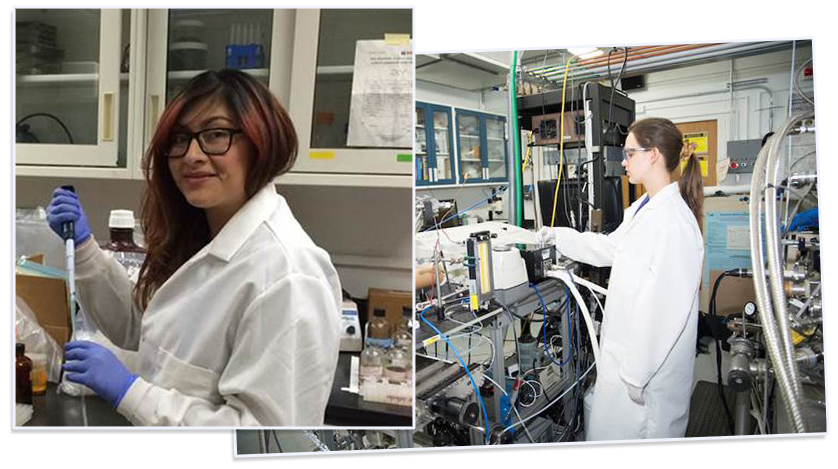
Erika Flores (left) and Elena Thomas (right) in the labs. Source: JPL
Eight community college students spent nine weeks in the labs at the University of Southern California describing the physiology and phylogeny of novel bacteria isolated from marine subsurface environments. Charbel Bou Khalil (Orange Coast College), Alex Cervantes (Cerritos College, Rio Hondo College), Raquel Diaz (Brookdale Community College), Angelica Escobar (Santiago Canyon College), Karen Ho (Pasadena City College), Stephen Hoefler (Mission College, West Valley College), Christopher Neely (Rio Hondo College), and Hillary Smith (Waubonsee Community College) were part of the Community College Cultivation Cohort (C4) summer residential internship program led by Jan Amend, PI of the Life Underground team. C4 was funded in part by an NSF-REU grant, the Center for Dark Energy Biosphere Investigations (C-DEBI), and the NASA Astrobiology Institute (NAI).The students learned and directly applied techniques including DNA extraction, genome sequence analysis, electron and epi-fluorescence microscopy, anaerobic cultivation, metabolism assays, and analytical chemistry. Their summer lab work resulted in two manuscripts: a genome announcement paper and a paper fully characterizing—and naming—the novel isolate. Postdoctorate Roman Barco, lab technician Pratixa Savalia, and USC undergraduate (and former C4 student) Karla Abuyen provided mentorship.

From top to bottom: Charbel Bou Khalil, Stephen Hoefler, Hillary Smith, and Angelica Escobar with mentor Karla Abuyen in the Amend lab; Alex Cervantes; (left to right, back row) Alex Cervantes, Karen Ho, Chris Neely, Stephen Hoefler, (left to right, front row) Angelica Escobar, Hillary Smith, and Raquel Diaz visiting JPL; Angelica Escobar at Curiosity “mission control.” Source: J. Amend/USC
SETI’s Research Experience for Undergraduates (REU) summer program introduced students to a wide range of topics including potential landing sites for human missions to Mars, calibration for exoplanet telescopes, models of protoplanetary disks, protoplanetary analogues in the rings of Saturn, and the astrophysical applications of SETI data.
REU intern Khanh Luu assisted senior scientist Dr. Virginia Gulick with Mars digital terrain modeling, where Khanh mapped the drainages of two gully systems of the Northwest Palikir crater. Her study could help researchers determine how the gullies were formed and shed light on the past climate and extent of water on Mars. Khanh used ENVI and ArcGIS to measures the slopes, lengths widths, areas, and volumes of these gully systems. She also delineated the drainage basin (catchment) area for each gully and mapped the entire gully drainage systems from finger-tip tributaries in the alcove source regions to the distributary channels on the debris aprons at the gully system terminus. She used CRISM Analysis Tools to study the gully systems’ mineralogy. Khanh also helped with a separate project in analyzing rock samples in thin sections, and obtaining several Raman spectra of each sample.
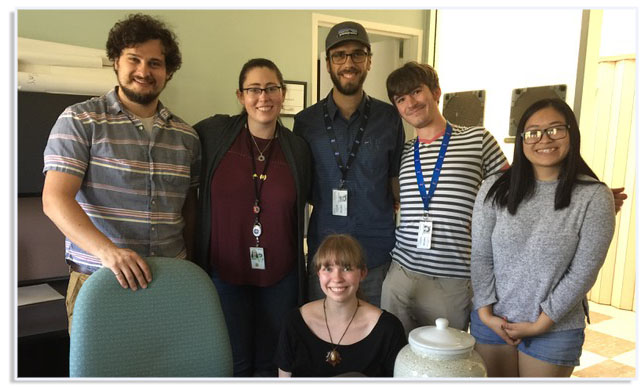
Khanh Luu (right) with Gulick’s 2017 summer research team. From left to right: visiting postdoc Dr. Tim Goudge (UT- Austin), SETI Institute research assistant Natalie Glines, NASA Summer interns Tyler Paladino (UCSC), Richard Nelson (UCSC), SETI REU Intern Khanh Luu (CSU-San Bernadino), and front center: NASA Intern Paige Morkner (CalPoly). Source: V. Gulick/NASA Ames
The University of Wisconsin-Madison Habitability, Life Detection, and the Signatures of Life on the Terrestrial Planets team’s summer students took part in a wide range of astrobiology research and outreach.Eric Boyd’s lab at Montana State University hosted Mariah Friedlander, a recent graduate of Salish Kootenai College, for a six-week summer internship. Mariah worked to develop laboratory skills associated with the isolation and characterization of extremophiles, specifically thermoacidophiles from Yellowstone hot springs supported by volcanic gases.
Mitchell Freyermuth, an undergraduate Summer Research Fellow at Furman University, was sponsored by Chris Romanek and investigated the factors that influenced the incorporation of trace and minor elements in carbonate minerals, as part of Mitchell’s senior thesis for his Earth and Environmental Sciences degree. His research could shed light on environmental conditions and factors that are responsible for the geochemistry of carbonate minerals on the surface of Mars.
UW-Madison microbiology major Evan Handowski, sponsored by Eric Roden, worked in the geomicrobiology lab with Ph.D. student Stephanie Napieralski on extracting DNA and measuring ATP content in cultures designed to grow microorganisms capable of generating energy from the oxidation of Fe(II)-bearing primary minerals.
Undergraduate Geoscience major Amanda Heinsohn, supervised by education and public outreach lead Brooke Norsted through the Geology Museum at UW-Madison, helped to organize a two-week astrobiology-themed summer camp for elementary school students. Lessons ranged from rover races and building Martian bases to exploring extremophiles and locations where NASA is looking for life in our solar system. In total, there were 28 kids ranging from 1st-5th grades participating in the program who, among the many activities, even got to design their own Mars “pasta rovers.”
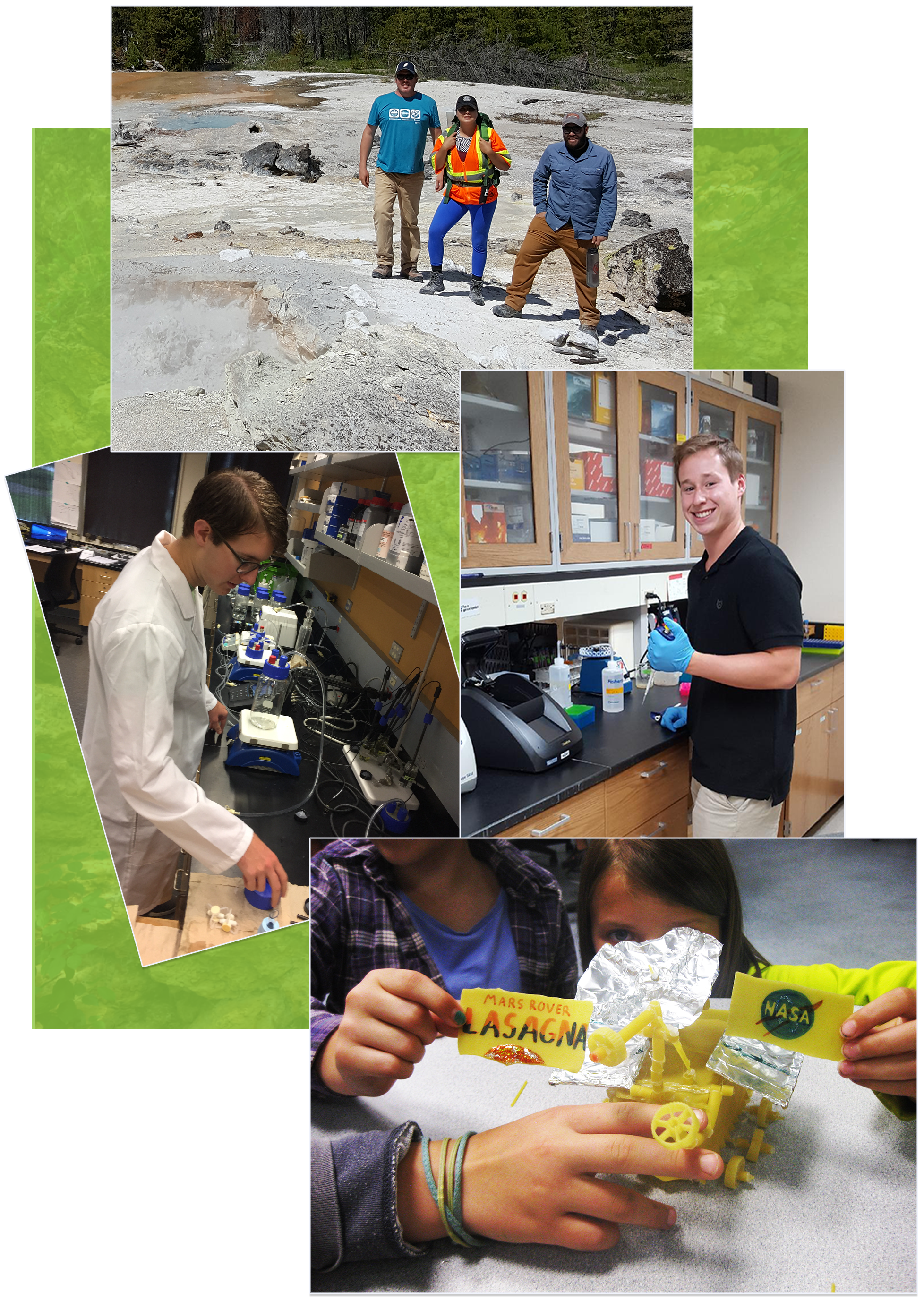
Clockwise from top: Mariah Friedlander (center); Evan Handowski; Amanda Heinsohn and the pasta rover, Lasagna; and Mitchell Freyermuth. Source: UW-Madison
We look forward to seeing where life after summer takes these young scientists, and anticipate hearing more updates about their work in the future!
- The NASA Astrobiology Institute Concludes Its 20-year Tenure
- Global Geomorphologic Map of Titan
- Molecular Cousins Discovered on Titan
- Interdisciplinary Consortia for Astrobiology Research (ICAR)
- The NASA Astrobiology Science Forum Talks Now on YouTube
- The NASA Astrobiology Science Forum: The Origin, Evolution, Distribution and Future of Astrobiology
- Alternative Earths
- Drilling for Rock-Powered Life
- Imagining a Living Universe
- Workshops Without Walls: Astrovirology